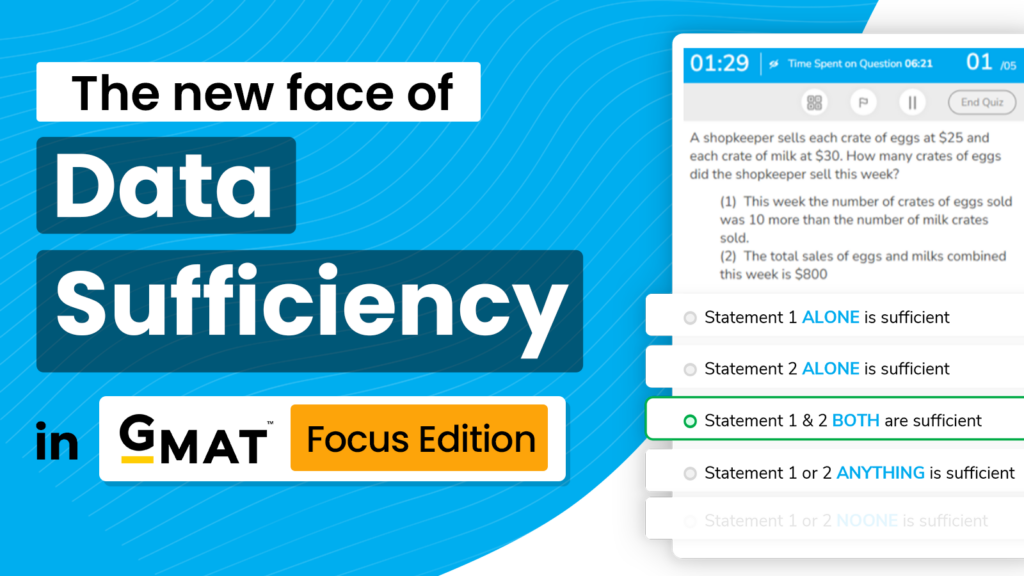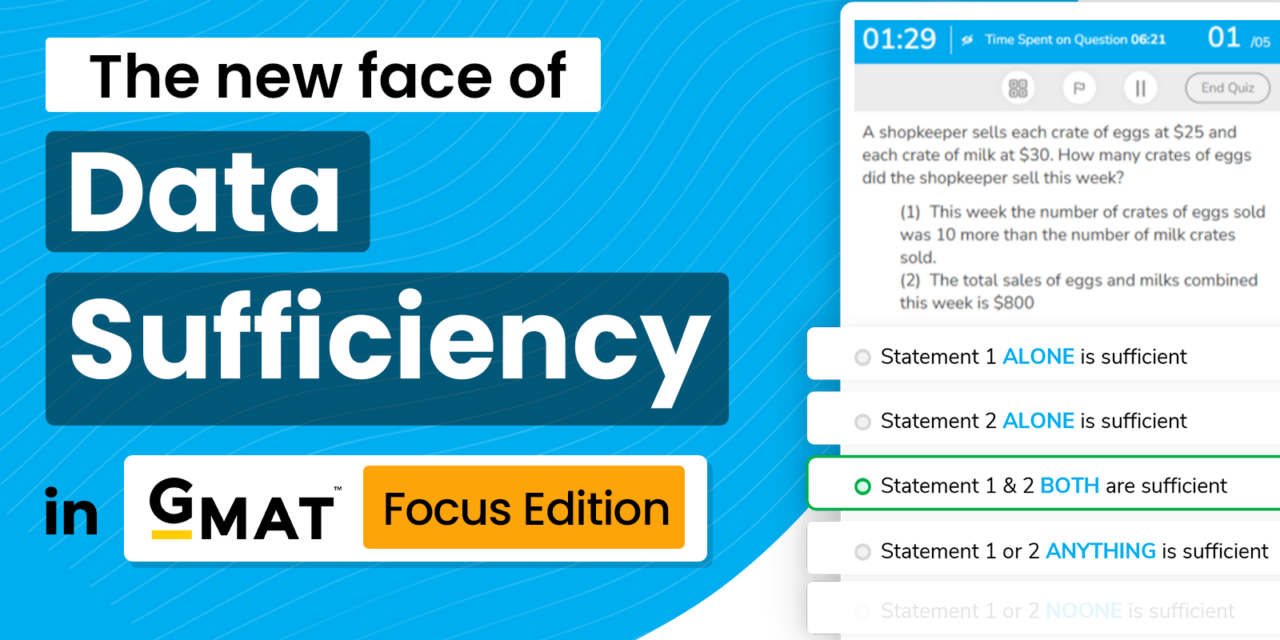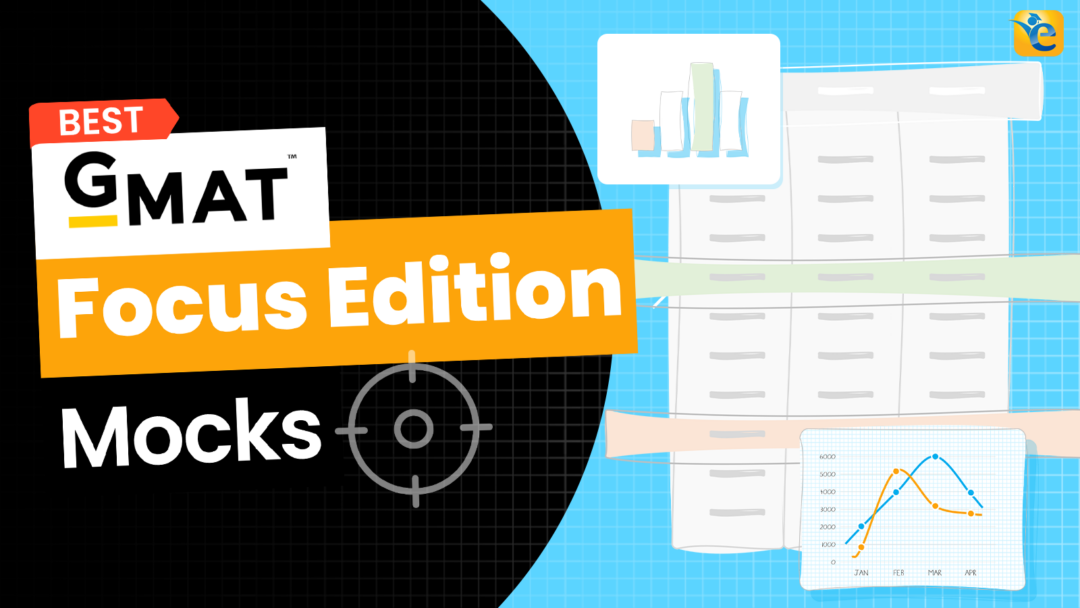Introduction
Fact: GMAT Focus Data Sufficiency questions are now part of Data Insights in GMAT Focus Edition.
What statement amongst the following resonates in your mind?
- Ok, it has just changed its home. Earlier it was in Quant, now it is in DI. No big deal.
- It is now less important because earlier, it was almost 40% of all Quant ~ 12 questions, but now it is one of the 4 question types in 20 questions, so around 5-6 questions.
- I am wondering if there are any other changes to these DS questions apart from where they are served, and how many are served.

Here is my take on the above:
- DS questions have evolved.
- No more pure context questions such as algebra or number properties.
- Only real-world context questions, implying that DS questions are primarily word problems type questions.
- And a new kind of DS question – Verbal Reasoning.
- DS questions are ever so important.
- If you are chasing the coveted 90% ile = 655+ score in GMAT Focus Edition, then DS is important for you, even if the number of DS questions may have halved.
- DS questions require specialized skills.
- Not only do you need to understand the approach to solving DS questions, but you also need to apply both your quant and verbal reasoning skills to solve DS questions.
Watch this Video to know more about the New Face of Data Sufficiency Questions in GMAT Focus:
GMAT Focus Data Sufficiency truly has been reformed. It’s a beautiful question type that tests the resilience and agility of the test taker.
There’s lots to talk about GMAT Focus Data Sufficiency questions. In this article, we will limit our discussion to giving you a flavor of new question types that have been added so that you can start building your skillset to solve such questions with ease!
So, let’s begin!
Start your GMAT Focus journey with our free GMAT Focus mock test to gauge your baseline score, and then create a personalized study plan. Dive into our free trial for targeted prep. Trusted by thousands with 2900+ reviews on GMAT Club, e-GMAT is your partner in mastering the GMAT. Contact us at support@e-gmat.com for expert guidance.
Two Types of Verbal Reasoning Questions
There are two types of these new GMAT Focus Data Sufficiency questions.
- Pure verbal reasoning questions
- Verbal reasoning questions that require some quant processing
1) Official hard question of type 1 – Pure verbal reasoning.
The couple decides one day that they will definitely go to the beach the next evening if it is sunny without rain at the time they plan to go—and that they will definitely not go if such is not the case. The next morning, the hour-by-hour weather forecast says that in the evening, it will be sunny without rain. Will the couple go to the beach that evening?
- It is raining in the morning and in the afternoon of the day of their planned beach outing.
- The couple always believe that the weather forecast is likely to be accurate.
2) Official hard question of type 2 – Verbal reasoning with quant processing.
A small library has books on twenty different subjects including, most prominently, history. One afternoon, a librarian arbitrarily picks up 100 books for reshelving from among the books returned that day. All the books returned that day were borrowed during the past three weeks. Are fewer than 20 percent of the books the librarian picks up on history?
- Fewer than 20 percent of the books in the library are on history.
- During the past three weeks, exactly 15 books on history were borrowed from the library.
As you can see, while the first question has no numbers whatsoever, the second question has numbers, percentages, etc. And that is the difference between the two question types. One tests pureplay verbal reasoning while the other adds a layer of quant reasoning. Now, while there are two types of questions, from a skillset standpoint you need the same base skillset to solve such questions accurately and efficiently.
Here is the link to the solutions of the above questions.
So, let’s talk about the skills required to solve such questions.
Skills
Skill 1: Owning the dataset
The need for this skillset
To understand the relevance of this skill, I will ask you to compare the scenarios described in the following two questions – both are official hard DS questions.
1) Quant Reasoning DS question
Of the apartments in a certain building, 75 have a balcony, 80 have a fireplace, and 30 have neither a balcony nor a fireplace. How many of the apartments in the building that have a balcony do not have a fireplace?
2) Verbal Reasoning DS question
The couple decides one day that they will definitely go to the beach the next evening if it is sunny without rain at the time they plan to go—and that they will definitely not go if such is not the case. The next morning, the hour-by-hour weather forecast says that in the evening, it will be sunny without rain. Will the couple go to the beach that evening?
Comparison of scenarios
Observe that students who know the concept of sets will be able to visualize the quant question right away through a Venn Diagram as shown below.

But since verbal reasoning questions do not fall under any such conceptual bucket, we need to build our skillset to be able to visualize the entire scene to the extent that we “own the dataset”.
Demonstration of “owning the dataset”
For this question, here is what it means:
- Per the scene described, there are two conditions that MUST be met for the couple to visit the beach tomorrow.
- Condition 1 – It should be sunny and not raining.
- Condition 2 – This should be the actual weather conditions on the evening of departure.
- And here are our notes representing the same – you should become skilled at taking such notes so that you do not need to refer to the passage once you read it and convert it into your own notes – i.e., once you own the dataset.

Ready to tackle the GMAT Focus Edition? e-GMAT offers a Personalized Study Planner and top-notch Free GFE mock exam to help you prepare effectively. As the most reviewed GMAT prep company on GMAT Club with 2900+ reviews we’re here to support your GMAT Focus journey. Take advantage of our free trial with the best quality content. Start your path to success today!
Skill 2: Visualizing The approach
Once you “own” the dataset, then to solve the question that has been asked, you need to visualize a solid approach. By this we mean that before you look at the statements, you should have very definite criteria to assess the two statements.
For this question, we need to answer the question “will the couple go to the beach”? Thus, the question is a yes/no question, i.e., the answer could be a definite yes or a definite no. The statement(s) provide sufficient information if we can arrive at a definite answer.
We need to know the actual weather tomorrow evening on two accounts – sunny and raining.
As you can see, if we “own the dataset”, we can visualize the framework to assess the statements.
Skill 3: Executing the DS Solution framework
Next we execute the visualized approach. This execution needs to be done using the DS solution framework. Let’s see it in action:
To answer the question asked, we need to know the actual weather tomorrow evening on two accounts – sunny and raining.
- Statement 1: It is raining in the morning and in the afternoon of the day of their planned beach outing.
- This statement does not tell us anything about the actual weather at the time of departure – tomorrow evening.
- Thus, choices A and D are eliminated. (choices B,C, and E are left in the running).
- This statement does not tell us anything about the actual weather at the time of departure – tomorrow evening.
- Statement 2: The couple always believes that the weather forecast is likely to be accurate.
- This statement does not tell us anything about the actual weather at the time of departure – evening. The couple’s trust in the weather forecast is irrelevant.
- Thus, choice B is eliminated. (choices C and E are left in the running).
- This statement does not tell us anything about the actual weather at the time of departure – evening. The couple’s trust in the weather forecast is irrelevant.
- Statement 1 and 2 combined:
- Both statements combined also do not tell us anything about the actual weather conditions at the time of departure.
- Thus, choice C is eliminated.
- Hence choice E is the correct answer.
So, you can see how each of the three skill sets is required to solve such DS questions accurately and efficiently.
Learning Data Sufficiency Solution Framework
Data sufficiency is a beautiful question type that requires the application of a robust framework. So, the most fundamental skill set required to ace DS questions is mastering the DS framework.
Owing to a very well-defined structure of DS questions, the process to approach these questions is the same regardless of whether the question is a quant question or verbal question. Here is the process in flowchart format.

The flow chart looks complex and for the right reasons. A GMAT newbie who has not seen a DS question ever before in their life will require effort to master the process. And because this mastery is so critical, we have created a specialized module called DS – Foundations in the e-GMAT DS course using which e-GMAT students master this process within three hours of dedicated effort.

Conclusion : (GMAT Focus Data Sufficiency)
If you think I am crazy to think that GMAT Focus Data Sufficiency questions are beautiful, just wait till you understand the soul of these questions.
Quant based DS questions were good. But verbal reasoning-based DS questions are truly a piece of beauty for they challenge us on so many fundamental levels and that helps build valuable life skills.
To solve the new Verbal Reasoning DS questions, one needs to build the following skills:
- Learn how to own the dataset.
- Learn how to visualize the approach to answer the question asked.
- Master the DS solution framework.
e-GMAT students build these skills in a progressive manner in a dedicated course specialized for Data Sufficiency questions. Watch this video to learn more.
Practice Question : GMAT Focus Data Sufficiency
Try your hand at this official hard verbal reasoning question with a flair of quant. Be sure to own the dataset. For this, immerse yourself in the situation. Think of yourself as the librarian in the scenario.
A small library has books on twenty different subjects including, most prominently, history. One afternoon, a librarian arbitrarily picks up 100 books for reshelving from among the books returned that day. All the books returned that day were borrowed during the past three weeks. Are fewer than 20 percent of the books the librarian picks up on history?
- Fewer than 20 percent of the books in the library are on history.
- During the past three weeks, exactly 15 books on history were borrowed from the library.
Here is the link to the solutions
Happy Learning!
Want to know where you stand on the GMAT Focus? Take our free GFE mock test and identify your baseline score. Get valuable insights into your performance, identify your strengths and weaknesses, and make an informed decision about your preparation path.













